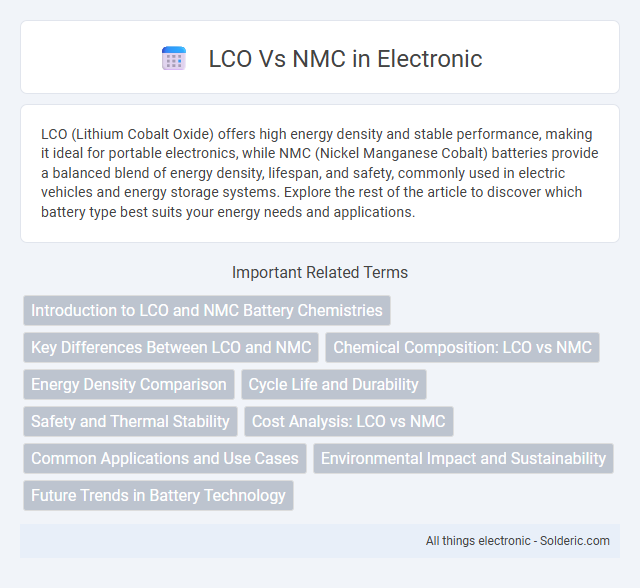LCO (Lithium Cobalt Oxide) offers high energy density and stable performance, making it ideal for portable electronics, while NMC (Nickel Manganese Cobalt) batteries provide a balanced blend of energy density, lifespan, and safety, commonly used in electric vehicles and energy storage systems. Explore the rest of the article to discover which battery type best suits your energy needs and applications.
Comparison Table
| Feature | LCO (Lithium Cobalt Oxide) | NMC (Nickel Manganese Cobalt Oxide) |
|---|---|---|
| Chemical Composition | LiCoO2 | LiNiMnCoO2 |
| Energy Density | High (around 150-200 Wh/kg) | Moderate to High (150-220 Wh/kg) |
| Cycle Life | Moderate (500-1000 cycles) | Longer (1000-2000+ cycles) |
| Thermal Stability | Lower thermal stability; risk of overheating | Better thermal stability and safety |
| Cost | Higher due to cobalt content | Generally lower; optimized cobalt usage |
| Common Applications | Consumer electronics like smartphones, laptops | Electric vehicles, power tools, energy storage |
| Environmental Impact | Higher cobalt mining concerns | Reduced cobalt; more sustainable mix |
Introduction to LCO and NMC Battery Chemistries
LCO (Lithium Cobalt Oxide) batteries feature a high energy density, making them ideal for portable electronics, while NMC (Nickel Manganese Cobalt) batteries offer a balanced combination of energy density, power, and thermal stability for electric vehicles and energy storage systems. LCO uses cobalt as the primary cathode material, which provides excellent capacity but at a higher cost and safety concern. NMC combines nickel, manganese, and cobalt to optimize performance, lifespan, and safety, making it more versatile for various applications; understanding these chemistries helps you choose the battery best suited for your needs.
Key Differences Between LCO and NMC
LCO (Lithium Cobalt Oxide) offers high energy density and longer cycle life, making it ideal for portable electronics but involves higher cobalt content, raising cost and ethical concerns. NMC (Nickel Manganese Cobalt) balances energy density, power output, and thermal stability, widely used in electric vehicles due to its improved safety and lower cobalt reliance. Your choice between LCO and NMC depends on prioritizing energy density or safety and cost-efficiency for battery applications.
Chemical Composition: LCO vs NMC
Lithium Cobalt Oxide (LCO) features a chemical composition of LiCoO2, where cobalt is the primary metal, providing high energy density but limited thermal stability. In contrast, Nickel Manganese Cobalt (NMC) combines lithium, nickel, manganese, and cobalt in varying ratios, such as LiNiMnCoO2, optimizing energy density, thermal stability, and longevity for diverse applications. Your choice between LCO and NMC batteries depends on the balance you prioritize between energy density, safety, and cost efficiency.
Energy Density Comparison
LCO (Lithium Cobalt Oxide) batteries typically offer an energy density around 150-200 Wh/kg, making them well-suited for high-energy applications like smartphones and laptops. NMC (Nickel Manganese Cobalt) batteries provide a higher energy density, ranging from 200 to 260 Wh/kg, which enhances performance in electric vehicles and energy storage systems. Choosing NMC can boost your device's runtime and efficiency due to its superior energy capacity.
Cycle Life and Durability
LCO (Lithium Cobalt Oxide) batteries typically offer lower cycle life, ranging between 300 to 500 cycles, compared to NMC (Nickel Manganese Cobalt) batteries, which can achieve 1,000 to 2,000 cycles or more. NMC batteries exhibit enhanced durability due to their balanced chemistry, allowing for better thermal stability and reduced capacity fade during prolonged use. These properties make NMC batteries more suitable for applications requiring long-term reliability and frequent charge-discharge cycles.
Safety and Thermal Stability
LCO (Lithium Cobalt Oxide) offers high energy density but has lower thermal stability, making it more susceptible to overheating and thermal runaway compared to NMC (Nickel Manganese Cobalt). NMC combines nickel, manganese, and cobalt, which enhances safety by improving thermal stability and reducing the risk of combustion during high-stress conditions. Choosing NMC batteries can provide your device with safer performance and better resilience against thermal issues.
Cost Analysis: LCO vs NMC
LCO (Lithium Cobalt Oxide) batteries typically have a higher raw material cost due to expensive cobalt, impacting overall production expenses compared to NMC (Nickel Manganese Cobalt) batteries. NMC batteries benefit from a more balanced use of nickel and manganese, reducing cobalt dependency and lowering cost per kWh. The cost advantage of NMC batteries makes them increasingly preferred in applications demanding cost-effective energy storage solutions.
Common Applications and Use Cases
LCO batteries are commonly used in consumer electronics and medical devices due to their high energy density and stable voltage output. NMC batteries excel in electric vehicles and power tools, offering a balanced combination of energy density, power, and longer life cycles. Your choice between LCO and NMC depends on whether you prioritize compact energy storage or enhanced performance and durability.
Environmental Impact and Sustainability
LCO (Lithium Cobalt Oxide) batteries have a higher environmental impact due to cobalt mining, which involves significant ecological degradation and ethical concerns, while NMC (Nickel Manganese Cobalt) batteries use a more balanced metal composition that reduces cobalt dependency. NMC batteries offer improved sustainability through better resource efficiency and longer lifespan, resulting in lower overall carbon emissions during production and use. Recycling advancements in NMC battery technology further enhance their environmental benefits compared to LCO.
Future Trends in Battery Technology
LCO (Lithium Cobalt Oxide) and NMC (Nickel Manganese Cobalt) batteries are evolving with future trends emphasizing higher energy density, improved safety, and cost reduction. NMC technology is gaining traction due to its balanced performance and scalability, while innovations in LCO focus on enhancing cycle life and thermal stability. You can expect continued advancements in cathode materials and solid-state electrolytes to boost battery efficiency and sustainability.
LCO vs NMC Infographic

 solderic.com
solderic.com